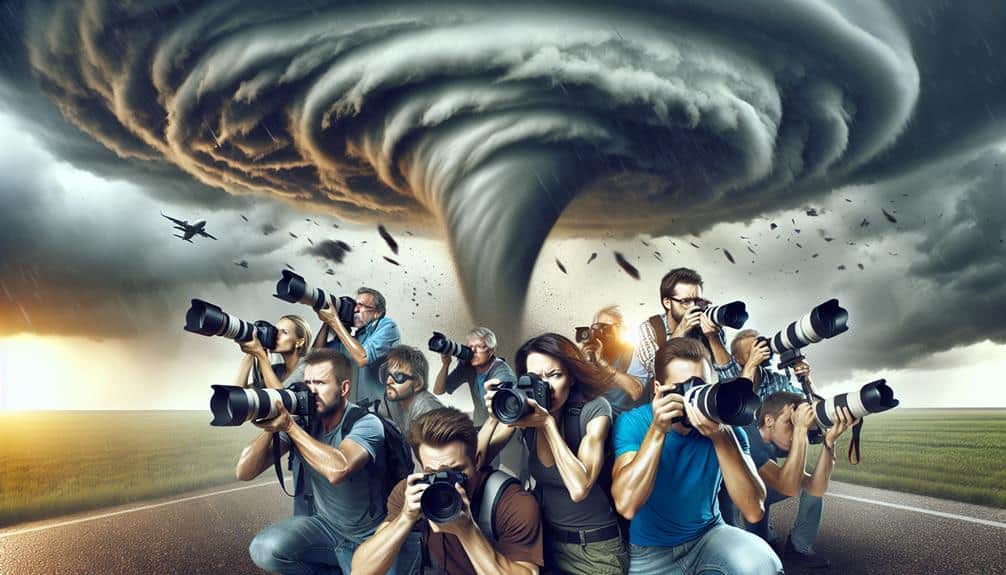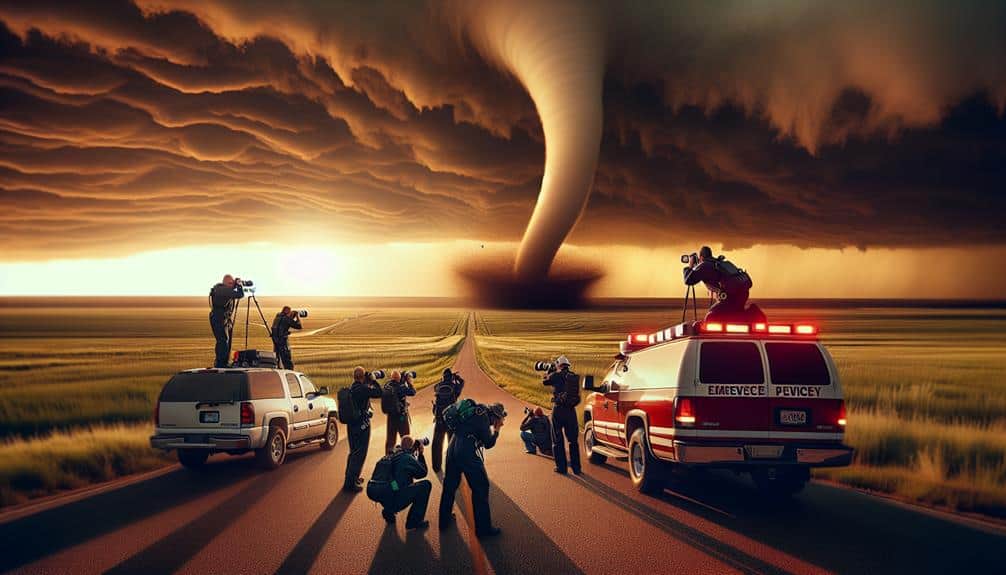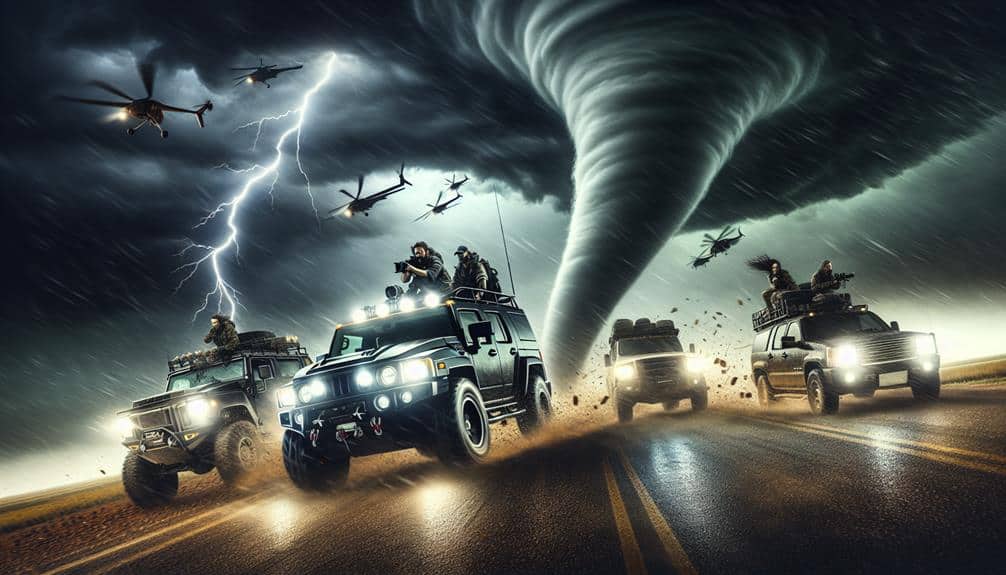We've seen the portrayal of veteran storm chasers shift from thrill-seekers to essential scientific contributors thanks to advancements in technology and changing public interest. Media now highlights their groundbreaking work, like Tim Samaras' tornado probes, Dr. Wurman's mobile Doppler radars, and Reed Timmer's real-time data collection. However, challenges persist with sensationalized coverage often overshadowing their scientific rigor. Collaborations with news outlets enhance accurate reporting and public safety. The inclusion of social media and emerging technologies continues to refine their portrayal and impact. Understanding these elements offers deeper insights into how storm chasers shape our weather awareness.
Key Points
- Veteran storm chasers like Tim Samaras, Dr. Wurman, and Reed Timmer have significantly advanced storm data collection and public awareness.
- Media coverage has evolved to highlight the scientific contributions and critical decisions of experienced storm chasers.
- Notable storm chasers utilize innovative techniques such as Doppler on Wheels and Dominator vehicles for precise storm tracking.
- Accurate media portrayals now emphasize the importance of storm chasers in meteorological science and public safety.
Evolution of Media Portrayal
Over the past few decades, we've witnessed a significant transformation in how media portrays storm chasers, driven by advancements in technology and shifts in public interest. Initially, storm chasers were often depicted through inaccurate portrayals, focusing on them as thrill-seekers rather than dedicated scientists. Sensationalized coverage emphasized the danger and excitement, overshadowing the essential research that these professionals conduct.
Technological advancements, such as high-definition cameras and real-time data feeds, have allowed for more accurate and dynamic reporting. This shift has helped the public see storm chasers as indispensable contributors to meteorological science. Data from the National Weather Service indicates that storm chasers provide vital on-the-ground observations, which improve severe weather warnings and save lives.
However, sensationalized coverage hasn't entirely disappeared. Some media outlets still prioritize dramatic footage over factual reporting, leading to misconceptions about the profession. Studies show that such portrayals can diminish the perceived credibility of storm chasers, impacting public trust and support.
Notable Storm Chaser Profiles
Let's focus on the career-defining moments and unique chasing techniques of notable storm chasers.
We'll highlight their most significant achievements and analyze the innovative methods they've employed to track severe weather.
Career Defining Moments
In examining the career-defining moments of notable storm chasers, we explore the pivotal events and groundbreaking discoveries that have shaped their contributions to meteorological science. These moments are often marked by critical decisions made in the face of unexpected obstacles.
For instance, Tim Samaras's decision to deploy his custom-designed probes directly in the path of tornadoes provided invaluable pressure and wind data, advancing our understanding of storm dynamics. This choice required precise timing and an unwavering commitment to safety, maneuvering unpredictable storm behavior.
Similarly, Dr. Wurman's deployment of the Doppler on Wheels (DOW) revolutionized the field, allowing for high-resolution radar data capture of tornado genesis. The critical decision to invest in mobile radar technology faced initial skepticism but ultimately provided unprecedented insights into storm structure and behavior. Dr. Wurman's team often contended with mechanical failures and severe weather conditions, yet their perseverance yielded transformative scientific data.
Meanwhile, Reed Timmer's relentless pursuit of extreme weather, despite numerous unexpected obstacles, has highlighted the importance of real-time data collection and public awareness. His encounters with vehicle breakdowns and rapidly changing storm paths underscore the unpredictable nature of storm chasing, simultaneously showcasing the resilience and adaptability required in this demanding field.
Unique Chasing Techniques
Several experienced storm chasers have developed unique techniques that have greatly advanced our understanding of severe weather phenomena. By employing strategic maneuvers and innovative strategies, they've not only increased safety margins but also enhanced data collection methods.
For instance, Tim Samaras's use of a probe deployment system allowed for near-ground measurements of tornado intensity, offering unprecedented insights into vortex structure.
We can't disregard the contribution of Reed Timmer, whose Dominator vehicles utilize reinforced exteriors to navigate closer to tornadoes than ever before. His approach combines high-risk strategic maneuvers with advanced instrumentation, providing real-time data that aids in predicting storm behavior.
Another remarkable figure is Dr. Josh Wurman, who pioneered the use of mobile Doppler radar units. His innovative strategies have enabled us to capture high-resolution radar data, leading to more accurate models of storm dynamics. By positioning these units strategically, Wurman has mapped wind fields with exceptional detail.
These experts demonstrate that the key to effective storm chasing lies in a blend of strategic acumen and technological innovation. Their contributions not only push the boundaries of meteorological science but also inspire a new generation of storm chasers excited to explore the untamed forces of nature.
Impact on Public Awareness
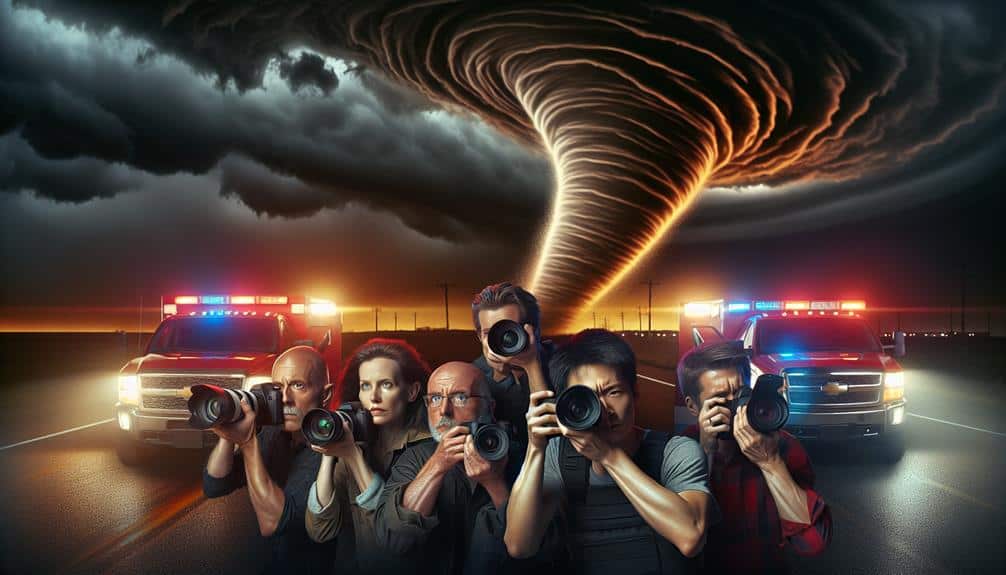
Veteran storm chasers enhance public awareness by providing real-time data and analyses, which are crucial for accurate weather forecasting and safety measures. Their efforts have a profound impact on media influence and community engagement, ensuring that critical information reaches those who need it most. By sharing live footage and detailed reports, these experts help demystify severe weather events, making them more understandable to the general public.
We observe that real-time storm data not only aids meteorologists in refining prediction models but also empowers communities to make well-informed decisions. When storm chasers relay their findings through various media channels, they amplify the reach and reliability of weather alerts. This direct line of communication fosters a sense of preparedness and resilience among viewers, who then take proactive steps to safeguard their lives and property.
Moreover, veteran storm chasers serve as trusted sources in the media landscape. Their firsthand accounts and scientific insights bridge the gap between complex meteorological data and public understanding. As a result, communities become more engaged and informed about weather-related risks, enhancing their overall safety.
Challenges in Media Representation
Media representation of storm chasers often distorts the scientific rigor and safety protocols that define their work. We frequently see misleading narratives that paint storm chasers as thrill-seekers, neglecting the critical data collection and analysis they perform. This underrepresentation of their scientific contributions leads to widespread misconceptions.
Media coverage tends to be sensationalized, focusing more on dramatic footage than on the meticulous planning and risk assessment involved. As a result, several key aspects are often overlooked:
- Scientific methodology: The intricate models and data analysis driving the decisions of storm chasers.
- Safety protocols: The strict measures taken to guarantee the safety of both the chasers and the public.
- Community collaboration: Partnerships with meteorological agencies and local authorities.
These stereotypes undermine the credibility of storm chasers, reducing their work to mere spectacle. By ignoring the scientific and educational facets, the media perpetuates misconceptions that can hinder public understanding.
We must advocate for more accurate and balanced portrayals to safeguard that the public appreciates the true value and integrity of storm chasers' work.
Collaborations With News Outlets
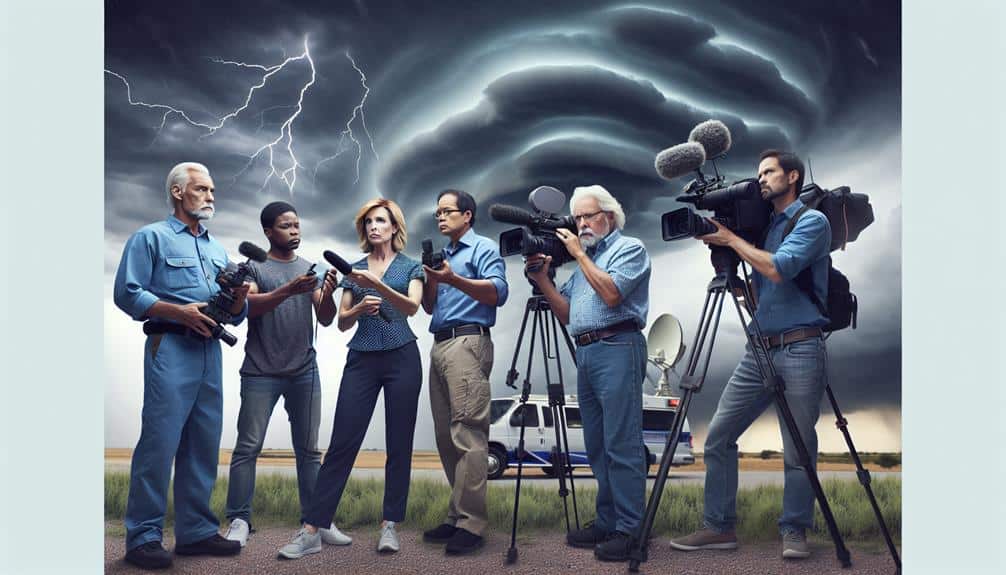
Partnering with news outlets enables storm chasers to disseminate real-time, scientifically accurate data to a wider audience, enhancing public safety and awareness. Through live broadcasts, we can provide instantaneous updates on storm trajectories, wind speeds, and potential hazards. These partnerships not only amplify our reach but also guarantee that the data shared is vetted by scientific experts, thereby maintaining a high level of accuracy and trust.
When we engage in exclusive interviews and features with major news outlets, we offer deeper insights into the phenomena we chase. These interviews allow us to explain complex meteorological concepts in layman's terms, empowering viewers with knowledge that could be life-saving. Additionally, these features often spotlight the rigorous methodologies we employ, from Doppler radar interpretation to storm pattern analysis, thereby educating the public on the scientific rigor behind storm chasing.
Integrating our data into the broader media landscape ensures that the information is accessible and actionable. By leveraging these collaborations, we not only fulfill our mission to study severe weather but also contribute to a well-informed, proactive public. Ultimately, these partnerships enhance both the scientific community and public safety efforts in meaningful ways.
Future Trends in Coverage
As we look toward future trends in coverage, we must focus on emerging technologies in reporting, effective social media integration, and real-time data utilization.
By leveraging advanced tools like drones and AI, we can enhance our storm tracking capabilities and provide more precise information.
Integrating this data with social media platforms will guarantee real-time updates reach a broader audience more efficiently.
Emerging Technologies in Reporting
Advancements in drone technology and real-time data analytics are revolutionizing how we report severe weather events, offering unprecedented accuracy and immediacy. We're leveraging AI journalism to automate data collection and generate insights swiftly, which enhances our capacity to deliver timely and relevant information. This technology facilitates immersive storytelling, enabling us to convey the intensity and scale of storms in ways never before possible.
Drone reporting is another game-changer. Equipped with high-definition cameras and sensors, drones can capture detailed footage from the heart of the storm, providing perspectives that were previously inaccessible. This footage can be seamlessly integrated into virtual reality coverage, giving our audience an up-close and personal experience of severe weather phenomena.
Key advancements include:
- AI-driven analytics: Real-time processing of vast data sets to predict weather patterns with higher accuracy.
- High-definition drone imagery: Capturing detailed, real-time visuals of storm systems.
- Virtual reality integration: Allowing viewers to experience storm events in a fully immersive environment.
Social Media Integration
We're tapping into the power of social media to enhance our storm coverage, leveraging platforms for rapid dissemination of vital information and real-time updates. Our integration strategy involves influencer partnerships, allowing us to expand our reach and engage a broader audience. By collaborating with influencers who specialize in meteorology or storm chasing, we can effectively amplify our message and guarantee timely delivery of essential weather alerts.
Engagement strategies are central to our approach. Utilizing platforms like Twitter, Facebook, and Instagram, we're able to foster a community that values immediate and accurate storm information. Our use of live streaming technology provides viewers with real-time visuals of storm developments, offering a dynamic and transparent look at unfolding weather events. This method not only keeps the public informed but also encourages interactive content, where viewers can ask questions and receive answers from experts on the ground.
Data shows that social media users are 70% more likely to trust information shared by influencers they follow. By harnessing this trust, we're able to deliver important updates more effectively. As we continue to evolve, our focus remains on integrating cutting-edge social media tools to keep the public safe and informed.
Real-Time Data Utilization
Building on our social media strategies, we're incorporating real-time data analytics to revolutionize storm coverage and enhance predictive accuracy. By leveraging cutting-edge technology, we aim to provide immediate, actionable insights during severe weather events. Our approach focuses on integrating robust data streams with advanced algorithms to create a thorough, real-time view of storm patterns.
This real-time data utilization allows us to:
- Improve forecasting accuracy: By analyzing extensive datasets in real time, we can predict storm paths and intensities with unparalleled precision.
- Enhance data visualization: Dynamic maps and graphical interfaces make intricate data accessible and understandable for a broad audience.
- Increase situational awareness: Live updates and alerts guarantee that both storm chasers and the public stay informed and prepared.
Our goal is to combine scientific rigor with practical application, empowering individuals and communities with the knowledge they need to make informed decisions. By embracing real-time data analytics and state-of-the-art data visualization techniques, we're paving the way for a new era in storm forecasting and public safety.
We believe in the power of freedom through information, ensuring everyone can stay ahead of the storm.
Frequently Asked Questions
How Do Storm Chasers Prepare for Extreme Weather Conditions?
We thoroughly prepare for extreme weather using advanced training techniques and strict emergency protocols. Our data-driven approach guarantees we're equipped with the latest scientific insights, maximizing our safety while maintaining the freedom to chase storms effectively.
What Type of Equipment Do Veteran Storm Chasers Use?
When it rains, it pours – and we're ready with exceptional camera gear and communication devices. Our equipment includes high-resolution cameras, GPS units, satellite phones, and weather radios, ensuring we capture and communicate every detail of the chase.
How Do Storm Chasers Ensure Their Safety During Severe Storms?
We prioritize safety protocols and communication strategies to guarantee our safety during severe storms. Our emergency response and risk management practices involve constant data analysis and real-time updates, enabling us to make informed decisions and minimize risks.
What Motivates Individuals to Become Storm Chasers?
Chasing storms is like riding lightning; we're driven by psychological motivations, the adrenaline rush, and career opportunities. Our passion for weather and scientific accuracy fuels us, offering the freedom to explore and document nature's fury firsthand.
How Do Storm Chasers Contribute to Scientific Research?
We collect critical data during severe weather events, which directly contributes to scientific advancement. Through research collaboration and detailed meteorological studies, we enhance our understanding of storms, aiding in more accurate forecasts and improved safety measures.
